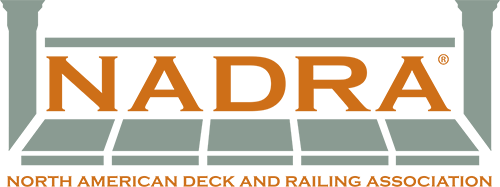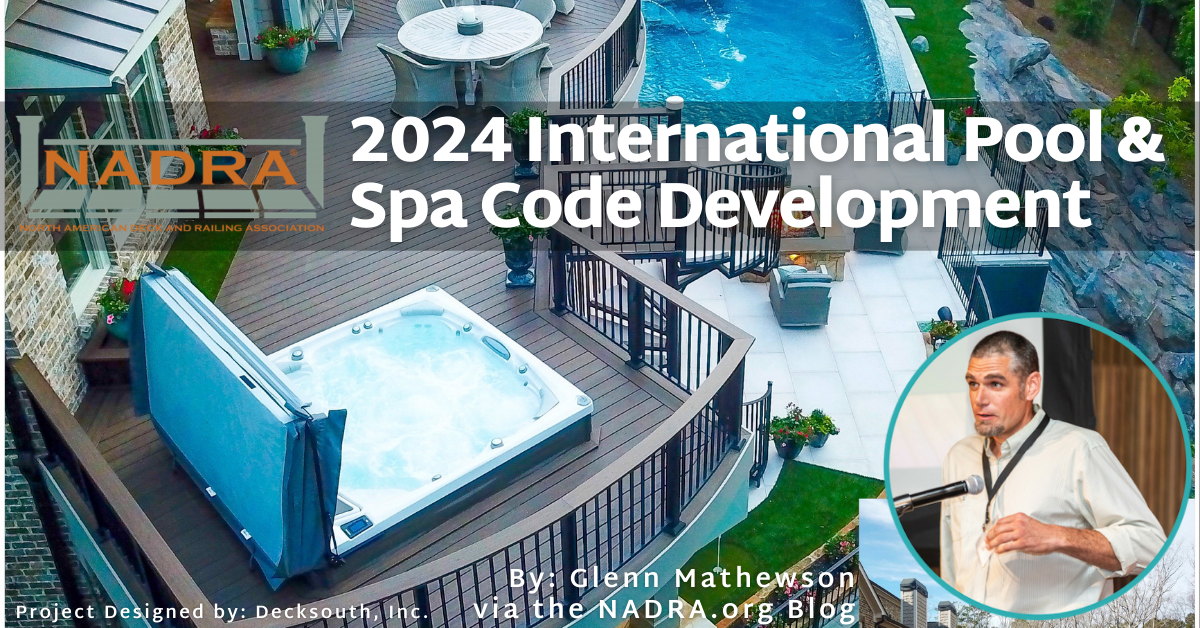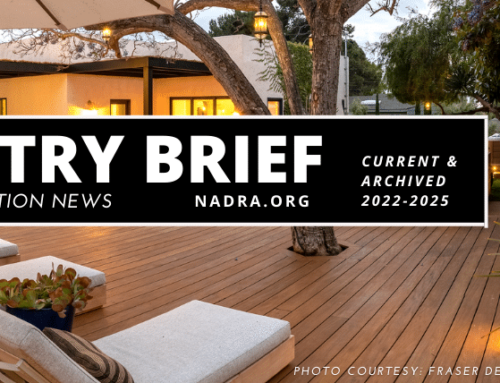Update from NADRA Code Committee Member, John Kozal:
Glenn Mathewson (NADRA Code Representative) attended the April 2021 ICC Committee Action hearings (Virtual) to help develop the 2021 International Swimming Pool and Spa Code. Here are the highlights:
Four (4) proposals were submitted under Section 306 titled “Decks:
- Slip Resistance Uses ASTM D 7032 as a Base for Serving Pool and Spa Decks: Needed a reasonable slip resistance metric so Glenn referenced ASTM D 7032 as a possible solution however that standard has no metric either per the opposition on the “floor”. So, Glenn asked the committee to disapprove his proposal. Glenn will come up with a different game plan before the Public Comment process this Summer.
- Stairs Serving Pool and Spa Decks Use IRC Details as a Standard: Glenn suggested that the pool code should reference the IRC for design and construction of stairs outside of the pool. Majority agreed to suggestion however that can change during Public Comment.
- Allow Slope and Gaps Serving Pool and Spa Decks but Eliminate Water Test: The current code requires pool decks to be sloped, gapped, and pass a test that no more than an 1/8th inch of standing water remains on the deck after 20 minutes. Glenn wanted to eliminate just the test however the committee disapproved but asked Glenn to come back at the public hearing to reduce the slope of ½” of rise for every 12” of run. Glenn will ask some pool professionals for their input before Public Comment.
- Gaps be Mandated While Allowing Slope as an Exception Serving Pool and Spa Decks: Glenn mandated that pool deck boards be gapped while a slope can be used as an exception. Majority agreed however that can change during Public Comment.
Glenn believes they made a good impression in front of the ICC Committee. Need to tighten up definitions between pools with concrete “decks” and pools with elevated decks.
Update from Glenn Mathewson:
On April 29th, 2021 NADRA code representative, Glenn Mathewson, participated in the International Code Council Committee Action Hearings for the development of the 2024 International Swimming Pool and Spa Code. This a relatively new code, introduced in 2012 and on its fourth revision, yet this is the first time the deck industry was there to contribute.
Slippery deck or slippery code?
We submitted four proposals for Section 306, not surprisingly titled, Decks. The first one of these in the schedule was also the most contentious, slip resistance. Since its inception, this code has required decks serving pools and hot tubs to be “slip-resistant and cleanable”. No guidance. No test standard. No metric of any sort is provided alongside this mandate. Imagine enforceable speed limit signs that have no posted speed. This type of code leaves far too much open-ended authority to building officials than should be tolerated by the public, and at the same time, puts far too much responsibility on building officials to make the determination without any support. Most inspectors want a code that has their back.
Let’s protect the products we use
Though this measureless mandate is clearly inappropriate, we chose as newcomers to the pool code to simply offer a proposal to allow natural wood decking and plastic composite decking tested according to the IRC required ASTM D 7032 test standard to be “considered slip-resistant and cleanable for the purposes of this section”. That was specifically chosen wording as to not make any claims that cannot be validated and to not affect any other industry’s products. The goal was to simply protect our conventional decking materials from suddenly being at risk of being considered non-compliant near hot tubs wherever this code is adopted.
The decision to be bold
However, we quickly attracted respectable opposition, prepared to testify what we already knew. The ASTM standard for composite decking doesn’t provide any quantitative values of what is slip-resistant, but we already stated that fact in our reason statement for the proposal. Regardless, that opposition was certain to derail the discussion about the real problem with this section. We then realized our mistake. We should have suggested deleting the entire undefined performance mandates for “slip-resistant and cleanable decking” for everyone. We submitted a floor modification to do this, but it was, unfortunately, ruled out of order. Admittingly, changing a modification proposal to a complete deletion was a stretch to ask for on the virtual hearing floor. To avoid “hearing theater” with an unintended discussion about the ASTM standard, we asked for disapproval of our proposal. We will revisit this again in the public comment portion of the process this summer.
Building stairs? Use the IRC.
The next proposal was to remove incomplete requirements for stairs serving pool and spa decks, that differed from the geometry in the IRC. We suggested the logical choice, that the pool code should reference the IRC for the design and construction of stairs outside of a pool. Shockingly, there was a bit of discussion from the committee on this, as there was concern that pool professionals building stairs serving pool decks should not have to reference the IRC for information. We politely suggested that perhaps they should and that there are far too many codes regarding stairs to duplicate them in a second code development process specific for pool deck stairs. In the end, the majority agreed, and this proposal was approved… at this stage of the process. That can change.
You mean you build decks level? Weird…
Our next proposal was to remedy current requirements that decks serving pools and spas must be sloped and must have gaps, as well as requirements that a deck must prove that after 20 minutes of wetting, there will be no more than 1/8-inch standing water. Please image that test occurring at final inspection, and let us know how you measure an 1/8 inch of water on a deck board… We were careful in this proposal to make as little change as possible, but to remove the weird 20-minute test procedure and simply ask for slope or gapping, but not both. We did not propose any change to the maximum ½:12 slope that has been in the code since inception, but strangely that is what the committee was hung up on. We were essentially disapproved because we didn’t change enough of the provision. However, the committee did appreciate our overall proposal and asked that we return with a public comment to reduce the allowable slope. We will need the help of our pool professional friends for an appropriate maximum slope for pool decks because most of our members build level decks.
If you don’t want gaps
Following this unapproved proposal, we did get our next proposal unanimously approved. It was a proposal in the section mandating deck board gaps, to allow the slope to be an exception to gapping. This was meant to work with and in reverse to a previously unapproved proposal to allow gaps to be an exception to the slope. So, it’s messy at the moment, but there are more steps before it’s finished. Taking a queue from the ANSI A117.1 code for accessible features, which allows up to a ½ inch gap on surfaces serving the more mobility challenged people, we suggested that is a reasonable maximum for backyard pool decks. The committee agreed.
We are different, but we can be friends
So we had an interesting first run in contributing to the ISPSC. We believe we made a good impression as honorable participants and confidently spoke on subjects we are experienced on. We learned that the term “pool decks” means very different things to different professionals, yet this code does not differ between them very well…yet… In the pool industry, it’s often concrete with various surface finishes, but in the decking industry, it’s an elevated and framed structure serving a hot tub. I think this was the root cause for much of the confusion about our proposals and how they would mesh with codes for concrete-type “decks”. We will continue to work with other industries that intertwine with ours to combine our knowledge and experience and help develop the most appropriate codes and standards we can.
By Glenn Mathewson,
NADRA Technical Advisor


